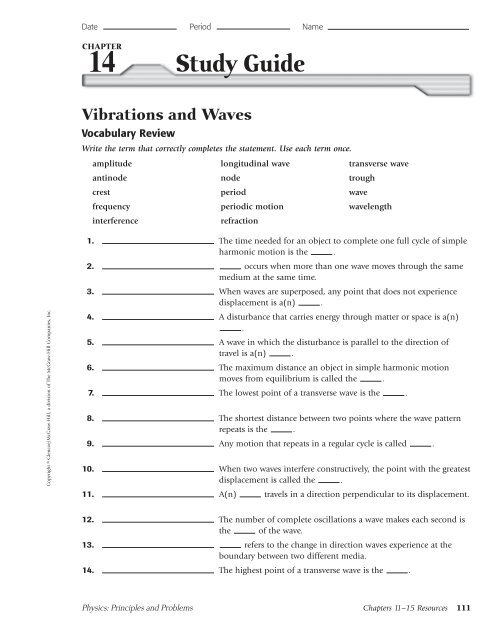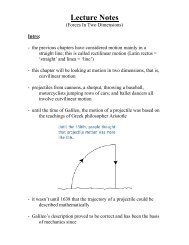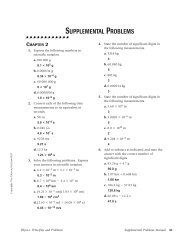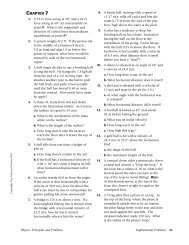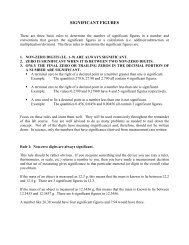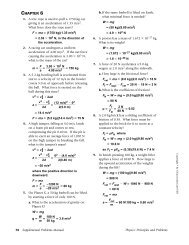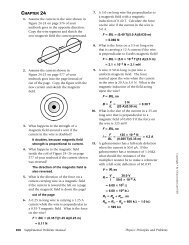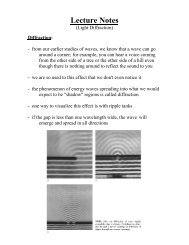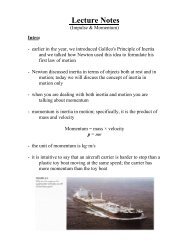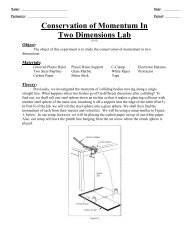Chpt. 14 Study Guide - Dickey Physics
Chpt. 14 Study Guide - Dickey Physics
Chpt. 14 Study Guide - Dickey Physics
Create successful ePaper yourself
Turn your PDF publications into a flip-book with our unique Google optimized e-Paper software.
Date Period NameCHAPTER<strong>14</strong> <strong>Study</strong> <strong>Guide</strong>Vibrations and WavesVocabulary ReviewWrite the term that correctly completes the statement. Use each term once.amplitudelongitudinal wavetransverse waveantinodenodetroughcrestperiodwavefrequencyperiodic motionwavelengthinterferencerefractionCopyright © Glencoe/McGraw-Hill, a division of The McGraw-Hill Companies, Inc.1. The time needed for an object to complete one full cycle of simpleharmonic motion is the .2. occurs when more than one wave moves through the samemedium at the same time.3. When waves are superposed, any point that does not experiencedisplacement is a(n) .4. A disturbance that carries energy through matter or space is a(n).5. A wave in which the disturbance is parallel to the direction oftravel is a(n) .6. The maximum distance an object in simple harmonic motionmoves from equilibrium is called the .7. The lowest point of a transverse wave is the .8. The shortest distance between two points where the wave patternrepeats is the .9. Any motion that repeats in a regular cycle is called .10. When two waves interfere constructively, the point with the greatestdisplacement is called the .11. A(n) travels in a direction perpendicular to its displacement.12. The number of complete oscillations a wave makes each second isthe of the wave.13. refers to the change in direction waves experience at theboundary between two different media.<strong>14</strong>. The highest point of a transverse wave is the .<strong>Physics</strong>: Principles and Problems Chapters 11–15 Resources 111
<strong>14</strong><strong>Study</strong> <strong>Guide</strong>NamecontinuedSection <strong>14</strong>.1Periodic MotionIn your textbook, read about springs and simple harmonic motion on pages 375–378.Answer the following questions. Use complete sentences.1. According to Hooke’s law, describe a graph of force versus displacement for an elastic spring.2. What does the slope of the graph in question 1 represent?3. What does the area under the curve in the graph in question 1 represent?4. What are the conditions necessary for simple harmonic motion?5. What is the relationship between the potential energy and the displacement of an elastic spring?6. A mass on a spring is moving in simple harmonic motion. When is the mass’s acceleration thegreatest? When is it the least? Why?7. Some cars have bumpers that are modified springs. How does this design protect the car in theevent of a crash?Copyright © Glencoe/McGraw-Hill, a division of The McGraw-Hill Companies, Inc.8. How does the mass of the bob on a pendulum affect the pendulum’s period?112 Chapters 11–15 Resources <strong>Physics</strong>: Principles and Problems
Namecontinued <strong>Study</strong> <strong>Guide</strong> <strong>14</strong>In your textbook, read about pendulums and resonance on pages 378–380.For each statement below, write true or rewrite the italicized part to make the statement true.9. The swing of a pendulum is an example of simple harmonic motion.10. The restoring force on a pendulum bob is inversely proportional tothe bob’s displacement.11. The net force on a pendulum at any given moment is opposite thependulum’s displacement at that moment.12. Resonance occurs when small forces are applied at regular intervalsto an oscillating or vibrating object and the amplitude of theobject’s oscillation decreases.13. In order to create resonance, the time interval between applicationsof force must be proportional to the period of oscillation.<strong>14</strong>. Pegs arranged in a circle on the floor beneath a swinging pendulumwill get knocked down because the floor is rotating as Earth rotates.Copyright © Glencoe/McGraw-Hill, a division of The McGraw-Hill Companies, Inc.Section <strong>14</strong>.2Wave PropertiesIn your textbook, read about mechanical waves and measuring waves on pages 381–386.Circle the letter of the choice that best completes the statement.1. A wave carries through space.a. matter c. both matter and energyb. energy d. neither matter nor energy2. A mechanical wave is different from other types of waves because it requires a(n) .a. amplitude c. mediumb. wave pulse d. disturbance3. A wave that moves from left to right, creating an up and down displacement of the medium, isa(n) .a. matter wave c. longitudinal waveb. mechanical wave d. transverse wave4. Sound waves are waves.a. longitudinal c. surfaceb. transverse d. electromagnetic5. A surface wave is a wave that has characteristics of .a. a transverse wave c. both transverse and longitudinal wavesb. a longitudinal wave d. neither transverse nor longitudinal waves<strong>Physics</strong>: Principles and Problems Chapters 11–15 Resources 113
<strong>14</strong><strong>Study</strong> <strong>Guide</strong>NamecontinuedFor each statement below, write true or rewrite the italicized part to make the statement true.6. Fluids usually transmit only transverse waves.7. Waves that travel down a rope are longitudinal waves.8. Waves deep under water are longitudinal waves.9. Waves on the surface of the ocean are transverse waves.10. A wave’s amplitude depends on its speed.Answer the following questions. Use complete sentences.11. How does wave speed relate to wavelength and period?12. Why do some waves have greater amplitudes than others?13. What does it mean for points on a wave to be in phase? What does it mean for points on a waveto be out of phase?<strong>14</strong>. What is the relationship between the amplitude of a wave and the rate of energy transfer?Copyright © Glencoe/McGraw-Hill, a division of The McGraw-Hill Companies, Inc.15. For waves with a constant velocity, what happens to the wavelength if the frequency of the wavedecreases?1<strong>14</strong> Chapters 11–15 Resources <strong>Physics</strong>: Principles and Problems
Namecontinued <strong>Study</strong> <strong>Guide</strong> <strong>14</strong>Section <strong>14</strong>.3Wave BehaviorIn your textbook, read about wave behavior on pages 387–391.For each statement below, write true or rewrite the italicized part to make the statement true.1. When a wave encounters a boundary, the wave that strikes theboundary is called the incident wave.2. When a wave encounters a boundary, the wave that returns to theoriginal medium is call the refracted wave.3. When a wave from a light, flexible spring passes into a heavier,stiffer spring, almost all of the wave’s energy is reflected back to thelight spring.4. When a wave is sent down a spring connected to a wall, none of theenergy in the wave is reflected back.5. When interference produces standing waves in a rope, the ropeappears to be standing still.Copyright © Glencoe/McGraw-Hill, a division of The McGraw-Hill Companies, Inc.Answer the following questions. Use complete sentences.6. What happens when a wave moves across a boundary from one medium to another? Consider twosprings, one large and one small, joined end-to-end. Describe the wave pulse moving from a largespring into a smaller one. Explain what happens to the energy in the incident wave.7. What is the principle of superposition?8. Draw a diagram of wave fronts and rays that represents refraction. Label the boundary. Use arrowsto show the change in direction.<strong>Physics</strong>: Principles and Problems Chapters 11–15 Resources 115
<strong>14</strong><strong>Study</strong> <strong>Guide</strong>NamecontinuedIn your textbook, read about waves in two dimensions on pages 390–391.Answer the following questions. Use complete sentences.9. What is a wave front?10. When is a wave refracted?11. A ray diagram shows the direction of wave motion. What is the normal? What does it show?12. What is the angle of incidence? What is the angle of reflection?13. What is the law of reflection?<strong>14</strong>. What causes an echo?15. How is refraction partly responsible for the formation of rainbows?Copyright © Glencoe/McGraw-Hill, a division of The McGraw-Hill Companies, Inc.16. What happens when a wave moves from deep to shallow water? How does the frequency change?116 Chapters 11–15 Resources <strong>Physics</strong>: Principles and Problems


